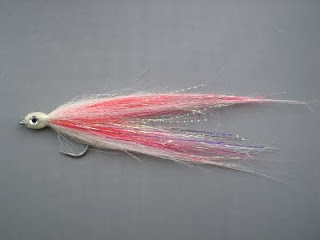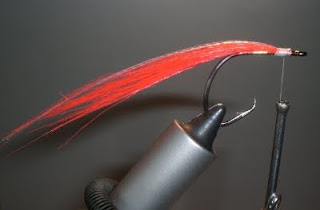
We spent the first day hanging around Polpero (Nr Looe). We decided to hire a boat and do a bit of fly fishing off the rocks. There were a few bass patrolling around, but we were mainly catching small sized Pollock that were tucked away near the rocks and hiding amongst the sea weed. Baz and Gav opted to spin for them. Gav at the time was casting away his big rubber shad when he had the first hit, but pulled out. Baz have given him a rusty hook, that was blunt. 'Good lad'. I saw him smirk. I managed to pull into a nice bass on a white Clouser, and after a bit of a tussle and some surface slapping it was in. Where's the photo? They refused to take one! They were too busy seeing who could do the most skims with a stone. That's brotherly love for you. The next bass that I had hooked ripped off into the sea weed and thrashed around until it came free. Checking the hook point when I pulled the fly in, it looked like it had been dragged across a rock and chipped the point off it. Er, or had it been pinged with a pair of pliers? Where was Baz at the time! Saying that probably hooking into clumps of sea weed and making out they were fish.
Stunning sun set over Looe rocks
The following morning we had booked to go out on a wreck fishing trip. We more or less had the boat to ourselves, apart from a couple on their honeymoon! Conger fishing. How romantic!! Saying that, it's probably the kind of thing that I would end up doing. So it was obvious that their day was going to be spoilt. We lifted Baz's boxes of tackle into the boat, and Gav just threw his pack of crisps onto the deck. Baz was busy talking to the skipper about the different methods and baits. Up or down tiding, rubby-dubby mixes and weather forecasts. The new couple were more interested in each other, Gav was nearly asleep, and I was more concerned about the size of the boat!
The sea was quite gentle, thank God, Baz and Gav had queasy stomachs from the night before. I wouldn't of minded a bit of swell, just to get things going for them. We headed out for about 8 miles before we dropped anchor, and got into the first tangle of the day! Trust it to be Gav! Not a clue. But completely chilled with the event. We managed to 'wind in' a good number of mackerel. Some were a nice size too. Baz thought he was the daddy, because he had a three'er. Until Gav landed a full string of fish. I think it was about 6.
Gav and his prize catch! Poor lad.
When the heavy artillery came out. and the baits were lowered to the depths of the reef, then the comp was on. Gav had caught all the bait that we needed. So it was my turn to blow Baz out of the water and the day would be sorted. Gav took an early lead with a scrappy 'doggie'. The first rule in the book was, who ever caught the first dog fish had buy tea when we got back onto shore, or is it dry land? Anyway, the fish and chips were on him. Baz massif, hooked into a decent conger, and the strain on his face was showing it. I though his head was going to explode!Ah, it fell off. He was gutted. He must of pulled it up a good 150' before it spat the hook. There were a few nice fish landed. Gav caught a stunning Cuckoo wrasse, and Baz caught the best tan of the day. Shame there were no pics of their fish. Funny that. But at least I had the last laugh and landed the biggest conger of the trip. Not huge, but it did me.












































